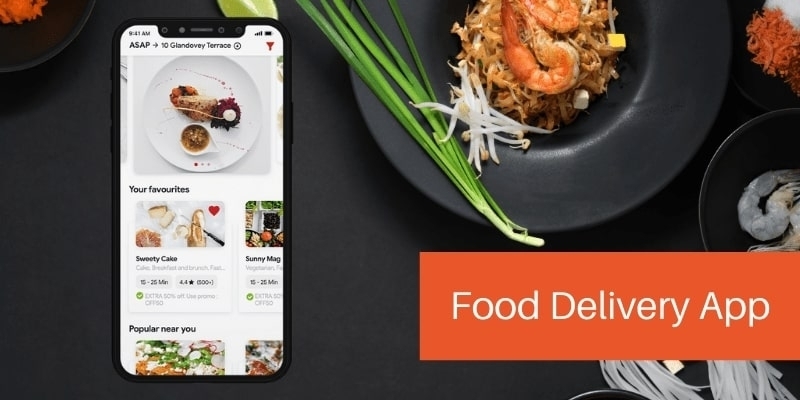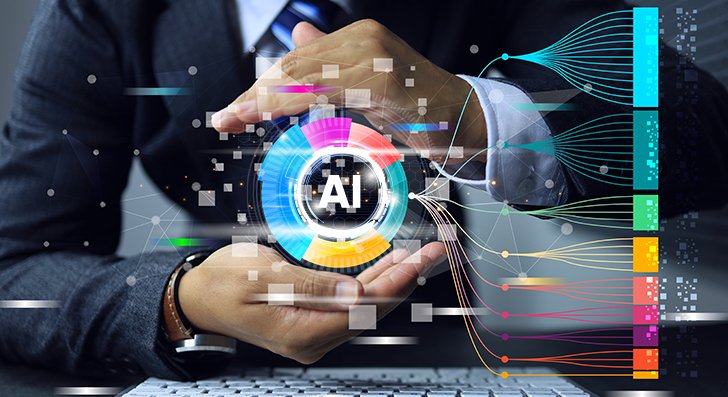The food delivery industry has experienced tremendous growth in recent years, driven by the increasing popularity of online ordering and the convenience of having meals delivered to one's doorstep. As technology continues to advance and consumer preferences evolve, there are exciting opportunities for startups to innovate and disrupt the food delivery market in 2025. This report explores some of the top food delivery app ideas that have the potential to revolutionize the dining experience.
Harnessing the Power of AI for Personalized Recommendations:
Artificial Intelligence (AI) has the potential to revolutionize the food delivery industry by providing personalized recommendations tailored to individual preferences. By leveraging AI algorithms, businesses can analyze vast amounts of data to understand customer behavior, tastes, and dietary needs. This enables them to offer highly relevant and engaging recommendations that increase customer satisfaction and loyalty.
One of the key benefits of AI-powered recommendations is their ability to enhance the user experience. By suggesting meals that align with customers' preferences, AI can help them discover new and exciting food options. This can lead to increased engagement and repeat business. Additionally, AI can personalize recommendations based on factors such as dietary restrictions, allergies, and nutritional goals, ensuring that customers receive options that meet their specific needs.
AI can also be used to optimize the food delivery process. By analyzing customer data, businesses can identify popular menu items, peak delivery times, and delivery routes. This information can be used to optimize inventory management, improve delivery efficiency, and reduce costs. Moreover, AI can be used to predict demand and allocate resources accordingly, ensuring that customers receive their orders on time and in good condition.
AI can help businesses identify emerging trends and opportunities in the food delivery market. By analyzing customer data and market trends, businesses can develop new menu items, partnerships, and marketing strategies that cater to evolving consumer preferences. This can help them stay ahead of the competition and maintain a competitive edge.
The successful implementation of AI-powered recommendations requires careful consideration. Businesses need to invest in the necessary infrastructure, data collection, and AI expertise. Additionally, they need to ensure that their AI algorithms are trained on high-quality data to provide accurate and relevant recommendations. Privacy and security are also important considerations, as businesses must protect customer data and ensure that AI systems are used ethically.
AI-powered recommendations offer significant benefits for the food delivery industry. By providing personalized experiences, optimizing operations, and identifying new opportunities, AI can help businesses increase customer satisfaction, loyalty, and profitability. As AI technology continues to advance, we can expect to see even more innovative and personalized experiences in the food delivery space.
Integrating Blockchain for Transparent and Secure Transactions
Blockchain technology, renowned for its decentralized and immutable nature, offers a promising solution for enhancing transparency and security in the food delivery industry. By leveraging blockchain, businesses can establish a trustless environment where all transactions are recorded and verifiable. This can significantly improve the overall integrity and efficiency of the food delivery process.
One of the key benefits of blockchain is its ability to provide transparency throughout the supply chain. Each transaction, from the sourcing of ingredients to the delivery of the final product, can be recorded on the blockchain. This creates a permanent and auditable record that can be accessed by all relevant stakeholders. Consumers can gain confidence in the authenticity and quality of their food by verifying its origin and journey through the supply chain.
Blockchain can also enhance the security of transactions by eliminating the need for intermediaries. Traditional food delivery systems often involve multiple parties, such as payment processors and delivery services, which can introduce vulnerabilities and risks. By utilizing blockchain, businesses can establish direct connections with customers and suppliers, reducing the potential for fraud and data breaches. Smart contracts, self-executing contracts with terms directly written into code, can automate processes and ensure that transactions are executed accurately and securely.
Furthermore, blockchain can improve traceability and accountability in the food industry. In case of food recalls or safety issues, blockchain can be used to quickly identify the source of the problem and trace affected products. This can help prevent widespread contamination and protect public health. Additionally, blockchain can facilitate the exchange of information between different parties, such as farmers, manufacturers, and retailers, enabling better collaboration and coordination.
However, the integration of blockchain into the food delivery industry also presents challenges. The technology can be complex and resource-intensive, requiring specialized expertise and infrastructure. Scalability is another concern, as blockchain networks can become congested with large volumes of transactions. Moreover, the adoption of blockchain may face resistance from traditional industry players who are reluctant to embrace new technologies.
Despite these challenges, the potential benefits of blockchain for the food delivery industry are significant. By enhancing transparency, security, and traceability, blockchain can improve the overall quality and safety of food products. It can also foster trust between consumers and businesses, leading to increased customer satisfaction and loyalty. As blockchain technology continues to evolve and mature, it is likely to play an increasingly important role in shaping the future of the food delivery industry.
Embracing Augmented Reality for Interactive Menus and Virtual Dining Experiences:
Augmented Reality (AR) has the potential to revolutionize the food delivery industry by providing immersive and interactive dining experiences. By overlaying digital information onto the real world, AR can enhance the way customers engage with menus and visualize their meals.
One of the key benefits of AR menus is their ability to provide customers with detailed information about dishes. AR can display nutritional facts, ingredient lists, and even visual representations of the food. This can help customers make informed choices and avoid allergens or dietary restrictions. Additionally, AR can be used to highlight special offers, promotions, and customer reviews, providing a more comprehensive and engaging dining experience.
AR can also be used to create virtual dining experiences. By allowing customers to visualize their meals before ordering, AR can help them better understand the presentation and size of dishes. This can reduce the likelihood of food waste and increase customer satisfaction. Furthermore, AR can be used to create interactive elements, such as games or quizzes, that can enhance the dining experience and make it more enjoyable.
AR can also be used to personalize the dining experience. By tracking customer preferences and behavior, AR can suggest tailored recommendations and offer personalized promotions. This can create a more engaging and relevant experience for customers, increasing their likelihood of repeat business.
However, the successful implementation of AR in the food delivery industry requires careful consideration. Businesses need to invest in the necessary technology and infrastructure, as well as develop high-quality AR content. Additionally, they need to ensure that their AR experiences are compatible with different devices and platforms.
AR offers significant opportunities for the food delivery industry to enhance the customer experience and drive innovation. By providing interactive menus, virtual dining experiences, and personalized recommendations, AR can create a more engaging and memorable dining experience. As AR technology continues to evolve, we can expect to see even more creative and innovative applications in the food delivery space.
Catering to the Rise of Vegan and Vegetarian Diets
The growing popularity of vegan and vegetarian diets presents a significant opportunity for food delivery businesses to expand their customer base and cater to evolving consumer preferences. By offering a diverse range of plant-based options, businesses can meet the needs of a growing demographic and contribute to a more sustainable food system.
One of the key challenges in catering to vegan and vegetarian customers is ensuring the authenticity and quality of plant-based dishes. Businesses need to source high-quality ingredients, develop innovative recipes, and train their staff to understand the nuances of vegan and vegetarian cuisine. Additionally, businesses should consider partnering with local farmers and suppliers who specialize in plant-based products to support sustainable and ethical sourcing.
Another important aspect of catering to vegan and vegetarian customers is providing clear and accurate information about the ingredients and preparation methods used in their dishes. This can help customers make informed choices and avoid cross-contamination with animal products. Businesses should also consider offering vegan and vegetarian-friendly substitutes for common ingredients, such as dairy, eggs, and meat.
In addition to offering a variety of plant-based options, businesses can also create a welcoming and inclusive environment for vegan and vegetarian customers. This can involve training staff to be knowledgeable about vegan and vegetarian diets and ensuring that the dining experience is enjoyable for all customers. Additionally, businesses can consider partnering with local vegan and vegetarian organizations to promote their offerings and reach a wider audience.
By catering to the rise of vegan and vegetarian diets, food delivery businesses can tap into a growing market and contribute to a more sustainable and ethical food system. By offering a diverse range of plant-based options, providing clear and accurate information, and creating a welcoming environment, businesses can meet the needs of vegan and vegetarian customers and establish themselves as leaders in the food delivery industry.
Prioritizing Sustainable and Ethical Food Sourcing
Consumers are increasingly concerned about the environmental and social impacts of their food choices. As a result, there is a growing demand for food that is sourced sustainably and ethically. Food delivery businesses can play a crucial role in meeting this demand by prioritizing sustainable and ethical food sourcing practices.
Sustainable food sourcing involves producing food in a way that protects the environment and ensures the long-term viability of natural resources. This includes practices such as organic farming, regenerative agriculture, and sustainable fishing. By sourcing ingredients from sustainable suppliers, food delivery businesses can reduce their environmental footprint and contribute to a healthier planet.
Ethical food sourcing refers to the production and trade of food in a way that respects human rights, animal welfare, and fair labor practices. This includes ensuring that workers are paid fair wages, working in safe conditions, and that animals are treated humanely. By sourcing ingredients from ethical suppliers, food delivery businesses can help to promote social justice and improve the livelihoods of farmers and workers.
Prioritizing sustainable and ethical food sourcing can also have significant benefits for food delivery businesses. By building relationships with sustainable and ethical suppliers, businesses can secure a reliable supply of high-quality ingredients. This can help to reduce costs, improve food safety, and enhance the reputation of the business. Additionally, by promoting sustainable and ethical practices, food delivery businesses can attract environmentally conscious customers and differentiate themselves from competitors.
However, implementing sustainable and ethical food sourcing practices can be challenging. Businesses may need to invest in new technologies, train their staff, and build relationships with sustainable and ethical suppliers. Additionally, they may need to be willing to pay a premium for sustainable and ethically sourced ingredients.
Despite these challenges, the benefits of prioritizing sustainable and ethical food sourcing far outweigh the costs. By taking a leadership role in this area, food delivery businesses can contribute to a more sustainable and equitable food system. By offering customers food that is produced in a responsible and ethical manner, businesses can build trust, loyalty, and a positive reputation.
Providing Healthy and Nutritious Meal Options:
In today's health-conscious society, consumers are increasingly seeking food delivery options that are not only convenient but also nutritious. By offering a variety of healthy and wholesome meal options, food delivery businesses can cater to the needs of a growing demographic and promote a healthier lifestyle.
One of the key challenges in providing healthy and nutritious meal options is ensuring the quality and freshness of ingredients. Businesses should source their ingredients from reliable suppliers who prioritize sustainability and ethical practices. Additionally, they should avoid using excessive amounts of processed foods, unhealthy fats, and added sugars.
Another important aspect of providing healthy and nutritious meals is offering a variety of options to cater to different dietary needs and preferences. This can include vegetarian, vegan, gluten-free, and low-calorie options. Additionally, businesses should consider offering meal plans that are tailored to specific health goals, such as weight loss or muscle gain.
In addition to the quality of ingredients and variety of options, businesses should also provide clear and accurate information about the nutritional content of their meals. This can include the number of calories, macronutrients, and micronutrients. By providing this information, customers can make informed choices and select meals that align with their dietary goals.
Businesses can enhance the nutritional value of their meals by incorporating healthy cooking techniques and using flavorful herbs and spices instead of relying on excessive amounts of salt and unhealthy fats. Additionally, they can focus on offering whole, unprocessed foods that are rich in nutrients and fiber.
By prioritizing healthy and nutritious meal options, food delivery businesses can differentiate themselves from competitors and attract a loyal customer base. Additionally, they can contribute to a healthier society by promoting healthy eating habits and reducing the prevalence of diet-related diseases. However, it is important to note that providing healthy and nutritious meals requires careful planning, sourcing, and preparation. By investing in these areas, food delivery businesses can offer a valuable service to their customers and make a positive impact on public health.
Implementing Real-time Tracking and Delivery Updates
In today's fast-paced world, consumers expect convenience and transparency from their food delivery services. One of the key factors that contribute to a positive customer experience is real-time tracking and delivery updates. By providing customers with accurate and up-to-date information about their orders, businesses can increase customer satisfaction, reduce anxiety, and improve overall service quality.
Real-time tracking involves using technology to monitor the progress of a delivery from the time it leaves the restaurant until it reaches the customer's doorstep. This can be achieved through a variety of methods, such as GPS tracking, barcode scanning, or RFID technology. By integrating real-time tracking into their operations, food delivery businesses can provide customers with accurate and timely information about their orders.
Delivery updates can be communicated to customers through a variety of channels, including SMS, email, or in-app notifications. By sending regular updates, businesses can keep customers informed about the status of their orders and address any concerns or questions they may have. This can help to build trust and improve customer satisfaction.
Implementing real-time tracking and delivery updates can also have significant benefits for food delivery businesses. By providing customers with accurate information, businesses can reduce the number of customer inquiries and complaints. This can free up customer service resources and improve overall operational efficiency. Additionally, real-time tracking can help businesses identify areas for improvement in their delivery process, such as inefficient routes or delays.
However, implementing real-time tracking and delivery updates can be challenging. Businesses may need to invest in new technology, train their staff, and integrate tracking systems with their existing operations. Additionally, they may need to address privacy concerns and ensure that customer data is handled securely.
Despite these challenges, the benefits of implementing real-time tracking and delivery updates far outweigh the costs. By providing customers with a seamless and transparent experience, businesses can build trust, loyalty, and a positive reputation. Additionally, real-time tracking can help businesses improve their operational efficiency and reduce costs.
Offering Subscription-Based Meal Plans for Convenience and Savings:
Subscription-based meal plans have become increasingly popular in recent years, offering consumers a convenient and affordable way to enjoy delicious and nutritious meals. By offering subscription-based meal plans, food delivery businesses can provide customers with a hassle-free dining experience and potentially increase their revenue.
One of the key benefits of subscription-based meal plans is convenience. By subscribing to a meal plan, customers can schedule regular deliveries and avoid the hassle of planning and preparing meals. This can be particularly beneficial for busy individuals or families who have limited time for cooking. Additionally, subscription-based meal plans can offer customers the flexibility to customize their orders, allowing them to choose from a variety of menu options and dietary restrictions.
Another advantage of subscription-based meal plans is the potential for cost savings. By subscribing to a meal plan, customers can often enjoy discounted prices compared to ordering individual meals. Additionally, some subscription-based meal plans offer bundled deals or loyalty programs that can further reduce costs.
However, implementing subscription-based meal plans can be challenging. Businesses need to invest in technology and infrastructure to manage subscriptions, process payments, and ensure timely deliveries. Additionally, they need to develop a variety of meal plans to cater to different customer preferences and dietary needs.
Despite these challenges, the benefits of offering subscription-based meal plans far outweigh the costs. By providing customers with a convenient and affordable dining experience, businesses can build loyalty, increase revenue, and differentiate themselves from competitors. Additionally, subscription-based meal plans can help businesses to stabilize their revenue stream and reduce the impact of fluctuations in demand.
Subscription-based meal plans offer a valuable service to consumers and can be a profitable business model for food delivery businesses. By providing convenience, cost savings, and a variety of meal options, businesses can attract and retain customers while promoting a healthier and more sustainable way of eating.
Conclusion:
The food delivery industry is poised for significant growth and innovation in 2025. By capitalizing on emerging technologies, addressing consumer needs, and expanding into new markets, startups can develop groundbreaking food delivery apps that redefine the dining experience. From leveraging AI for personalized recommendations to embracing augmented reality for interactive menus, the possibilities are endless. By focusing on sustainability, ethical sourcing, and healthy meal options, startups can also contribute to a more positive and responsible food delivery landscape. As the industry continues to evolve, it is essential for startups to stay agile, adapt to changing consumer preferences, and embrace technological advancements. By doing so, they can position themselves for success in the competitive world of food delivery and create a lasting impact on the way people eat.
For more information contact : support@mindnotix.in
Mindnotix Software Development Company


 AI-Taxi App
AI-Taxi App AI-Food App
AI-Food App AI-Property Mgmt App
AI-Property Mgmt App AI-CRM
AI-CRM AI-Fantasy App
AI-Fantasy App
 Web Development
Web Development App Development
App Development Business & Startup
Business & Startup Hire Developer
Hire Developer
 Digital Marketing
Digital Marketing Lead-generation
Lead-generation Creative Agency
Creative Agency Branding Agency
Branding Agency Augmented Reality
Augmented Reality Virtual Reality
Virtual Reality Internet of Things
Internet of Things Artificial Intelligence
Artificial Intelligence Blockchain
Blockchain Chatbot
Chatbot



